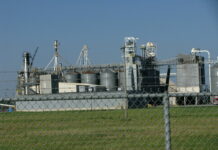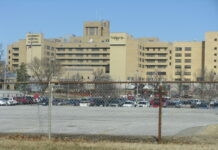Photo credit: DiasporaEngager (www.DiasporaEngager.com).
Paul F. Ehlers, MD1,2; Amy Deitche2; Leslie M. Wise, PhD3; Sarah L. Patrick, PhD3; Alfreda Holloway-Beth, PhD4; Ross Ellison5; Jordan Trecki, PhD6; Roy Gerona, PhD5; Michael S. Wahl, MD1,2 (View author affiliations)
View suggested citation
Altmetric:
Citations:
Views:
Views equals page views plus PDF downloads
Bromazolam is a “designer” triazolobenzodiazepine synthesized in 1976 but never approved for therapeutic use (1). Since its first detection in Sweden in 2016, a significant increase has persisted in both the toxicologic identification of bromazolam in combination with fentanyl and its identification in counterfeit benzodiazepine preparations (2). The number of law enforcement seizures in the United States that involved bromazolam increased from no more than three per year during 2016–2018 to 2,142 in 2022, and 2,913 in 2023.* In Illinois, bromazolam-involved† deaths increased from 10 in 2021 to 51 in 2022.§ Although human studies with clinical data are limited, animal models suggest bromazolam acts predominantly as a sedative, similar to other benzodiazepines, and to date, no signal for hyperthermia, myocardial injury, or seizures attributable to bromazolam intoxication exists (3). Although mostly detected alongside fentanyl or other opioids (88%–100% of tested samples),¶ consumption of bromazolam can be life-threatening even in the absence of other drugs. This report discusses a cluster of three young adult patients who were treated at local emergency departments for hyperthermia, seizures, and myocardial injury after consuming bromazolam disguised as alprazolam. This activity was reviewed by CDC, deemed not research, and was conducted consistent with applicable federal law and CDC policy.**
Case Series
On February 1, 2023, in a southern suburb of Chicago, three previously healthy young adults, two men aged 25 years (patients A and B) and a woman aged 20 years (patient C), ingested pressed tablets of bromazolam that they reported they believed to be alprazolam, a drug prescribed for anxiety and panic disorders, but which is misused recreationally because its effects include disinhibition and euphoria. They were found unresponsive by patient A’s mother approximately 8 hours later. All three received naloxone from emergency medical services without response and were unresponsive on arrival at local emergency departments.†† Patient A was hypertensive (blood pressure measurement = 152/100 mm Hg), tachycardic (heart rate 124/minute), and hyperthermic (temperature = 101.7°F [38.7°C]); pupils were dilated but reactive, and he experienced multiple generalized seizures. He was intubated to maintain airway control. Patient B was hyperthermic (temperature = 100.4°F [38.0°C]) and was intubated because of unresponsiveness and multiple generalized seizures. Patient C was obtunded with focal seizures and was intubated. All three had myocardial injury as demonstrated by elevated troponin levels. Urine drug screen for all three patients was positive for benzodiazepines. None of the patients received flumazenil, a benzodiazepine overdose antidote that can precipitate benzodiazepine withdrawal and cause seizures or tachyarrhythmias (4). All were admitted to an intensive care unit, and the Illinois Poison Center was contacted for assistance in evaluation and management (Table).
Patient A required intubation until hospital day 5 because of depressed mental status. After extubation, he had moderate aphasia and dysphagia, and was discharged on hospital day 11 with persistent neurologic deficits. Patient B was extubated on hospital day 1 and discharged on day 4 with mild hearing difficulty, but otherwise neurologically intact. Patient C progressed to status epilepticus despite administration of multiple antiepileptic medications (lorazepam, propofol, levetiracetam, and valproic acid), and persistent coma. She was transferred to a second hospital on day 11 and was subsequently lost to follow-up. Testing of serum (the preferred body fluid) or plasma samples from all three patients by the Drug Enforcement Administration’s Toxicology Testing Program (DEA TOX)§§ confirmed the presence of bromazolam (range = 31.1–207 ng/mL), without the presence of fentanyl or any other opioid.
Preliminary Conclusions and Actions
Bromazolam has been misrepresented¶¶ as a benzodiazepine approved by the Food and Drug Administration. The constellation of signs and symptoms in this case series is unexpected for a benzodiazepine overdose, which might 1) be a product of anoxic brain injury attributable to prolonged obtundation, 2) represent additional features of bromazolam in overdose or withdrawal, or 3) be due to an additional intoxicant not detected on liquid chromatography–mass spectrometry. Since 2021, 114 cases analyzed via DEA TOX had specimens that were positive for bromazolam, with mean blood levels reported as 44.8 ng/mL. Bromazolam has also been detected in drivers arrested for driving under the influence, in whom it produced a largely sedative toxidrome (5).
It is essential that physicians, medical examiners, toxicology laboratories, public health officials, and emergency responders be aware of the increased presence of bromazolam both in polydrug ingestions and in substance use disorder patients who report the use of benzodiazepines. Clinically, this knowledge can inform prognosis (two out of three patients in this cluster had confirmed recovery to near independence) and could indicate the need for aggressive seizure control. From a public health perspective, the constellation of findings reported should prompt close involvement with public health officials and regional poison centers, given the more severe findings in these reported cases compared with those expected from routine benzodiazepine overdoses. Clinicians, responders, and health officials should also consider bromazolam in cases of patients requiring treatment for seizures, myocardial injury, or hyperthermia after illicit drug use, as occurred in these case reports. Bromazolam intoxication should also be suspected in patients with a sedative toxidrome who do not respond adequately to naloxone reversal. In cases of suspected bromazolam exposure, clinicians should call their poison center for additional guidance. Testing for bromazolam is not routinely available but can be arranged through a variety of send-out reference laboratories.***
1Toxikon Consortium, Chicago, Illinois; 2Illinois Poison Center; 3Division of Emerging Health Issues, Office of Health Promotion, Illinois Department of Public Health, Springfield, Illinois; 4Epidemiology Unit, Cook County Department of Public Health, Chicago, Illinois; 5Clinical Toxicology and Environmental Biomonitoring Lab, University of California San Francisco, San Francisco, California; 6Drug and Chemical Evaluation Section, Diversion Control Division, Drug Enforcement Administration, Arlington, Virginia.
References
- Manchester KR, Lomas EC, Waters L, Dempsey FC, Maskell PD. The emergence of new psychoactive substance (NPS) benzodiazepines: a review. Drug Test Anal 2018;10:37–53. https://doi.org/10.1002/dta.2211 PMID:28471096
- Mérette SAM, Thériault S, Piramide LEC, Davis MD, Shapiro AM. Bromazolam blood concentrations in postmortem cases—a British Columbia perspective. J Anal Toxicol 2023;47:385–92. https://doi.org/10.1093/jat/bkad005 PMID:36715069
- Hester JB Jr, Von Voigtlander P. 6-Aryl-4H-s-triazolo[4,3-a][1,4]benzodiazepines. Influence of 1-substitution on pharmacological activity. J Med Chem 1979;22:1390–8. https://doi.org/10.1021/jm00197a021 PMID:42799
- Penninga EI, Graudal N, Ladekarl MB, Jürgens G. Adverse events associated with flumazenil treatment for the management of suspected benzodiazepine intoxication—a systematic review with meta-analyses of randomised trials. Basic Clin Pharmacol Toxicol 2016;118:37–44. https://doi.org/10.1111/bcpt.12434 PMID:26096314
- Papsun DM, Chan-Hosokawa A, Lamb ME, Logan B. Increasing prevalence of designer benzodiazepines in impaired driving: a 5-year analysis from 2017 to 2021. J Anal Toxicol 2023;47:668–79. https://doi.org/10.1093/jat/bkad036 PMID:37338191
| Characteristic | Patient A | Patient B | Patient C |
|---|---|---|---|
| Age, yrs; sex | 25; Male | 25; Male | 20; Female |
| Blood pressure, mm Hg | 152/100 | Unknown | 132/109 |
| Bromazolam level, ng/mL (plasma or serum) by LCMS | 207 (plasma) | 70.5 (plasma) | 31.1 (serum) |
| Heart rate per min | 124 | Unknown | 118 |
| In-hospital neurologic recovery (HD) | Yes (HD 5) | Yes (HD 1) | No |
| Myocardial injury (peak troponin, ng/L) | Yes (154) | Yes (239) | Yes (430) |
| Neurologic deficits at discharge | Moderate aphasia | Hearing loss | Unknown |
| Other LCMS findings using plasma (level, ng/mL) | 8-aminoclonazolam (0.2)* | Aripiprazole (NQ), methamphetamine (0.5),† midazolam (NQ) | None |
| Rhabdomyolysis (finding) | Yes (CK 4067/Cr 1.41) | No | No |
| Seizures | Multiple | Multiple | Refractory status epilepticus |
| Temperature | 101.7°F (38.7°C) | 100.4°F (38.0°C) | 98.8°F (37.1°C) |
| Urine drug screen result | BZD | AMP, BZD, THC | BZD |
Abbreviations: AMP = amphetamine; BZD = benzodiazepine; CK = creatinine kinase; Cr = creatinine; HD = hospital day; LCMS = liquid chromatography–mass spectrometry; NQ = not quantified; THC = delta-9 tetrahydrocannabinol.
* 8-aminoclonazolam is the primary metabolite of the designer BZD clonazolam, which is the 1,4-triazolo derivative of clonazepam. 0.2 ng/mL is under the lower limit of quantification (0.4 ng/mL) but above the lower limit of detection (0.1 ng/mL).
† Above the lower limit of detection (0.4 ng/mL) but below the lower limit of quantification (6.0 ng/mL).
Suggested citation for this article: Ehlers PF, Deitche A, Wise LM, et al. Notes from the Field: Seizures, Hyperthermia, and Myocardial Injury in Three Young Adults Who Consumed Bromazolam Disguised as Alprazolam — Chicago, Illinois, February 2023. MMWR Morb Mortal Wkly Rep 2024;72:1392–1393. DOI: http://dx.doi.org/10.15585/mmwr.mm725253a5.
MMWR and Morbidity and Mortality Weekly Report are service marks of the U.S. Department of Health and Human Services.
Use of trade names and commercial sources is for identification only and does not imply endorsement by the U.S. Department of
Health and Human Services.
References to non-CDC sites on the Internet are
provided as a service to MMWR readers and do not constitute or imply
endorsement of these organizations or their programs by CDC or the U.S.
Department of Health and Human Services. CDC is not responsible for the content
of pages found at these sites. URL addresses listed in MMWR were current as of
the date of publication.
All HTML versions of MMWR articles are generated from final proofs through an automated process.
This conversion might result in character translation or format errors in the HTML version.
Users are referred to the electronic PDF version (https://www.cdc.gov/mmwr)
and/or the original MMWR paper copy for printable versions of official text, figures, and tables.
Questions or messages regarding errors in formatting should be addressed to
mmwrq@cdc.gov.
Source of original article: Centers for Disease Control and Prevention (CDC) / Morbidity and Mortality Weekly Report (MMWR) (tools.cdc.gov).
The content of this article does not necessarily reflect the views or opinion of Global Diaspora News (www.GlobalDiasporaNews.com).
To submit your press release: (https://www.GlobalDiasporaNews.com/pr).
To advertise on Global Diaspora News: (www.GlobalDiasporaNews.com/ads).
Sign up to Global Diaspora News newsletter (https://www.GlobalDiasporaNews.com/newsletter/) to start receiving updates and opportunities directly in your email inbox for free.

































